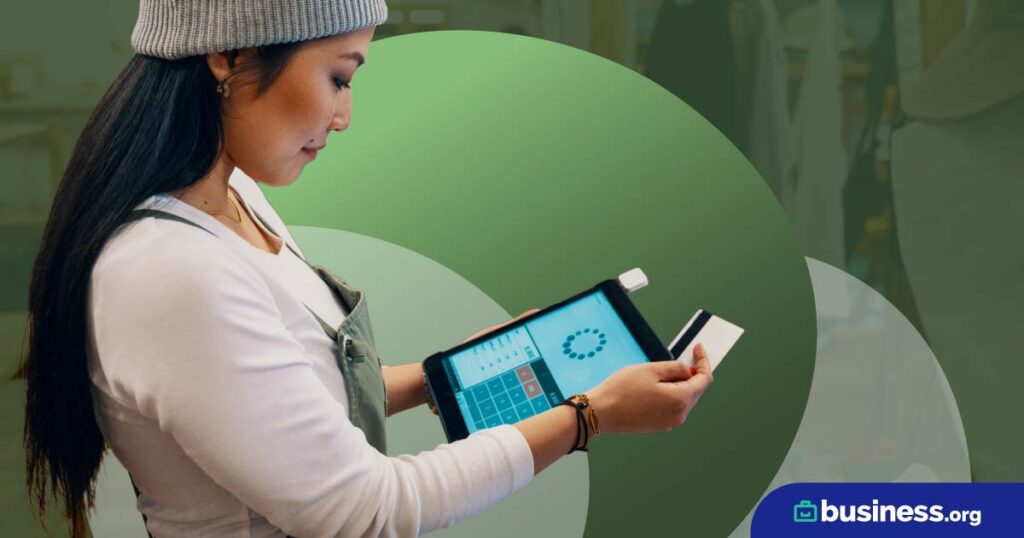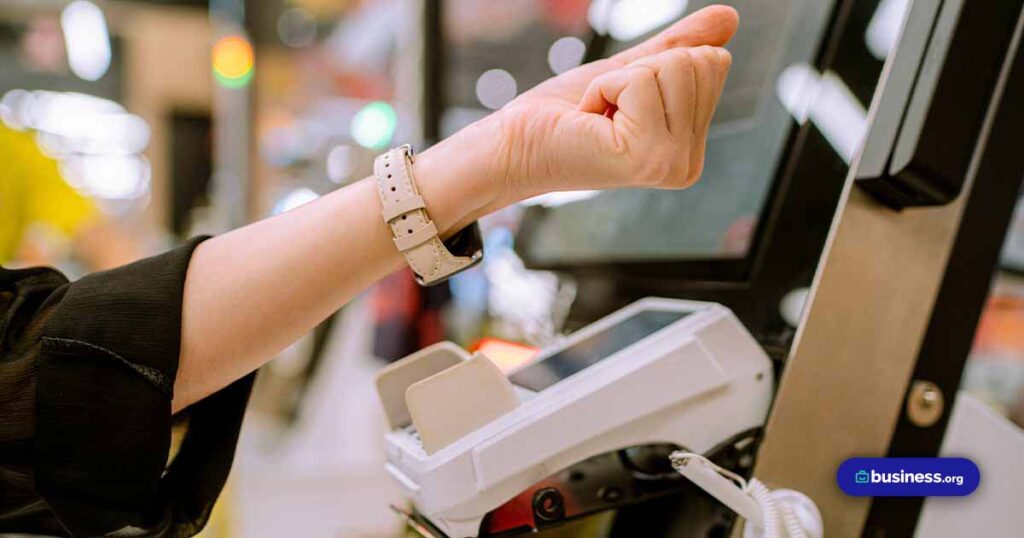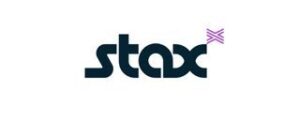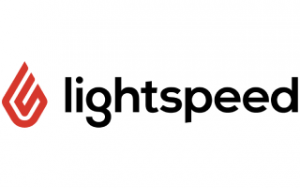We are committed to sharing unbiased reviews. Some of the links on our site are from our partners who compensate us. Read our editorial guidelines and advertising disclosure.
The 5 Best Point-of-Sale Systems for Small Businesses 2023
Data as of post date. Offers and availability may vary by location and are subject to change.
*Free trial for the first 14 days
The bottom line: Our top choice is Square, a POS system with features designed specifically around modern small businesses. It’s free to get started and easy to grow with. But if you’re looking for something more tailored to your industry, we’ve reviewed some other great options as well.
Our top picks combine payment processing, inventory and customer management, payroll and accounting, and other services into fully-featured POS hardware and software packages. Check out our top picks to learn more about which POS solution is best for your business.
- : Best overall POS
- : Best processing fees
- : Best for restaurants
- : Best for inventory management
- : Best for retail stores
Compare the best POS systems plans and pricing 2023
Data as of post date. Offers and availability may vary by location and are subject to change.
*Free trial for the first 14 days
When comparing POS brands, the starting price is only a small part of the equation. If you can afford multiple brands listed above, your next step will be finding a solution with features that fit your needs.
For example, Stax is one of the most expensive programs listed, but it also has the cheapest processing fees. With a high transaction volume, the savings from low processing fees can add up fast.
It’s important to note that in addition to the prices listed above, you may need to account for the cost of purchasing or renting point-of-sale hardware. Hardware options can range from free mobile readers to stationary smart terminals that can cost up to a thousand dollars. The best hardware option for you will be the one that flows easiest into your business model.
If you plan on using the hardware for the foreseeable future, you may want to consider buying over renting.
Square Point of Sale: Best overall
Data as of post date. Offers and availability may vary by location and are subject to change.
Our pick for the best POS system for small-business owners is Square. It’s free to start, easy to use, and chock-full of useful features. These benefits make Square a great choice for new business owners who need simple but powerful features from the get-go.
Square is a common favorite of mobile businesses like food trucks and boutique retail shops. That’s why we picked Square as the best mobile POS system for small businesses in another article. Whether you’re running a mobile or stationary business, however, Square offers hardware packages that suit all business needs.
Taking customer payments is easy with Square’s credit card readers and point-of-sale mobile app, which works with most Android and Apple devices—many Square users run their businesses with iPads. You can create customized receipts to send via email or print from a receipt printer. Plus, you can keep open tabs, split checks, and manage your inventory in real time—all within Square’s point-of-sale software.
Square provides detailed reporting and analytics and lets you send invoices, track employee shifts and timecards, and manage multiple locations. You can also run email marketing, customer loyalty plans, and gift card programs from Square’s point-of-sale software.
Now the downsides. Transaction fees with Square Point of Sale can be more expensive than what other POS providers are charging. The transaction costs can add up if you process loads of payments a day.
That said, Square POS doesn’t have a monthly fee, and the company keeps its transaction fees pretty simple (for the most part):
- Tapped, dipped, and swiped payments: 2.6% + $0.10
- Keyed-in and card-on-file payments: 3.5% + $0.15
- Card not present payments: 6% + $0.30
Square also offers other plans geared for certain types of businesses. With Square for Restaurants, for example, you get POS software that’s geared specifically for restaurant use. The plan costs $60 per month for each of your locations, plus an extra $40 per month for each additional POS system you use.
Square for Retail plans have the same monthly fees as the Square for Restaurants plan, but they come with discounted transaction fees (2.5% + $0.10 for in-person payments).
What’s nice about these additional plan types is that they are optional. So, if you want more functionality and features, it’s easy to add them to your POS at any time with Square.
Stax: Best processing fees
Data as of post date. Offers and availability may vary by location and are subject to change.
Stax was designed with one simple idea in mind: saving money on processing fees. Stax does not charge a single cent for its processing services. Bear in mind that you’ll still have to pay processing fees, but the only fees you’ll pay are the interchange fees.
Interchange fees are the fees charged by the credit card companies. They usually range from 1.15% to 3.25% and are dependent on too many factors to name. The one weakness of Interchange-only fees is its harder to predict how much you’ll pay in fees per month. Still, you will certainly be paying less in fees than you would be processing with anyone else.
One of the best things about interchange-only pricing is that your savings add up the more you process. Stax processing fees are a great way to guarantee a healthy bottom line if you are scaling your business sales.
Depending on what kinds of features you need in addition to a low transaction rate, Stax offers a number of plans to choose from.
Data as of post date. Offers and availability may vary by location and are subject to change.
As you can see in the plan details, Stax doesn’t have a ton of interesting bells and whistles. It’s mostly designed for processing transactions. But that’s sometimes all you need to get the job done.
Toast: Best for restaurants
Data as of 7/7/23. Offers and availability may vary by location and are subject to change.
Toast is a POS system built for restaurant owners. It’s a one-two-punch combo of smart software and intuitive hardware.
Its handheld POS devices, for example, allow restaurants to improve efficiency as servers send orders directly from the table to the kitchen. That means no more time wasted inputting orders on a single stationary device shared by all servers.
Toast also has a number of features that modern restaurants need for a healthy bottom line. That includes online ordering and delivery tools that make it easy to manage digital orders. Many restaurants get lost in the complicated process of managing online and in-store orders, so this feature is a vital management tool.
Toast can get a bit expensive depending on the plan. But with each plan comes unique and useful new features. The plan you choose will ultimately be the one best suited to your restaurant's needs and goals.
Data as of post date. Offers and availability may vary by location and are subject to change.
The biggest downside of Toast is that it doesn’t quite have its customer service dialed in yet. Some users online complain of long wait times and difficulty getting to the root of certain technical problems. This is not the case for all customers, but we’d like to see consistently positive reviews of Toast’s customer service before we amend our review.
With so much on offer, Toast is a hard POS system to turn down. Especially if you are looking for a way to automate your restaurant.
Lightspeed: Best POS system for inventory management
Data as of post date. Offers and availability may vary by location and are subject to change.
Keeping track of your inventory can be a nightmare if you don’t have the right tools. Lightspeed can save you time and hassle with its powerful inventory management tools built into a solid iPad POS system.
Lightspeed’s inventory management makes it easy to track and control your inventory:
- Create product variations like size, color, and material
- Bundle items to sell together
- Track inventory levels and SKUs at multiple locations
- Import up to 10,000 items
- Automate discounts
- Track unit costs
- Anticipate shopping trends
There’s so much you can automate with Lightspeed’s inventory tools, taking the headache out of a lot of your daily processes.
Lightspeed offers four different plans:
- Lean for $69 per month
- Standard for $119 per month
- Advanced for $199 per month
- Enterprise for a custom quote
Each plan has increasingly more features. With Lean, you get POS software, payment processing, and a free terminal. Standard adds accounting integration, Advanced adds loyalty tools, and Enterprise adds detailed analytics. All plans have transaction fees of 2.6% + $0.10 per transaction.
Lightspeed has made it possible to do international business on its systems no matter your plan. While many POS systems only operate in the US or in their home countries, Lightspeed allows you to manage businesses in multiple countries using one system.
That’s why Lightspeed is a truly unique system for businesses
Shopify POS: The best POS system for retail stores
Data as of post date. Offers and availability may vary by location and are subject to change.
Shopify gained a reputation in the retail space as a premier web-based POS platform. The company now over 1 million business customers worldwide using its ecommerce, Amazon marketplace, and point-of-sale services.1
The company’s powerful ecommerce integration translates into an impressive point-of-sale solution for retail brick-and-mortar stores too. Shopify POS is a service that’s easy to set up and highly customizable to fit small businesses and scale up as your business grows.
Shopify offers three major plans plus a scaled-down “Lite” plan for doing retail business on Facebook and a scaled-up “Plus” plan for high-volume merchants. Plans differ in their monthly price, payment processing fees, and features and services.
The $29 Basic Shopify plan is an affordable option for smaller retail businesses that are online, in a single retail location, or selling in-person at pop-up stores and local markets.
Shopify’s transaction fees are also a little complicated. Online or keyed transactions range from 2.4% + $0.30 to 2.9% + $0.30, depending on your plan. Meanwhile, in-person transaction fees fall between 2.4% to 2.7%—again, depending on your plan.
If you opt to use a payment provider other than Shopify Payments, however, you’ll also be assessed a third-party payment provider fee, which can be anywhere from 0.5% to 2% per transaction. So if you want to use a Shopify system and Shopify software, you may want to steer clear of Square, PayPal, or other payment gateways.
Data as of post date. Offers and availability may vary by location and are subject to change.
*Free trial for the first 14 days
By signing up I agree to the Terms of Use and Privacy Policy.
POS systems: Honorable mentions
There are dozens more POS system options for businesses to choose from. While the ones above represent our favorites, there are two more that are worth mentioning:
Honorable mentions
- : Best loyalty program
- : Best alternative restaurant POS
Honorable mentions plans and pricing
Data as of post date. Offers and availability may vary by location and are subject to change.
Revel Systems: The best POS system for customer loyalty
Data as of post date. Offers and availability may vary by location and are subject to change.
Customer relationship management (CRM) tools can help turn passive, infrequent buyers into loyal advocates for your brand. One POS provider we looked at, Revel Systems, offers what we think is the best CRM service to come packaged with an iPad restaurant POS system.
The Revel Systems POS system was mostly created for bars, quick-service restaurants, coffee shops, and breweries. Food and beverage service businesses can benefit from Revel’s customizable loyalty programs.
In addition, Revel Systems is built to speed up front-of-house order taking with its Mobile Order Taker system, which communicates seamlessly with stationary devices. And comprehensive inventory, analytic reports, and QuickBooks integration can help you understand your business and customers better.
Installation and onboarding of Revel’s POS system costs $674. After that, you’ll be paying $99 a month per terminal which is billed annually and requires a 3-year contract.
Revel does not list its processing fees, but we were able to get in contact with an agent who said the flat rate is 2.49% + $0.15 per transaction if you’re using Revel hardware. You can also use your own processor. If you have an existing processing fee statement, Revel says they are willing to provide a custom rate.
Touch Bistro: Best alternative restaurant POS
Data as of post date. Offers and availability may vary by location and are subject to change.
Touch Bistro is a strong contender in the restaurant POS world. It’s a fully featured system with a lot flexibility so you don’t pay for services you don’t need.
Data as of post date. Offers and availability may vary by location and are subject to change.
Paying the base fee gets you access to Touch Bistro’s POS software. That software includes a ton of useful features for restaurants:
- Menu management tools
- Reporting and analytics
- Tableside ordering
- Floor plan and table management
- Staff management
- Integrations collection
These basic tools are all most businesses need to run a successful restaurant. You can customize your menu with ease, making changes as needed. You can track sales cycles and plan for upcoming surges. And you can track and manage staff performance.
If these basic features aren’t enough, Touch Bistro also offers a number of paid add-ons. This system of à la carte add-ons is both a good and bad thing. It can save you money if you only need to use one or two add-ons. But it can start to be expensive if you find yourself wanting to use a lot of the add-ons.
We’d like to see Touch Bistro offer a deal on bundled add-ons to increase the savings of businesses that would like to use more than just a few. You could be paying up to $571.00 per month to use the base system and all add-ons. That’s just too much. A $499.00 bundle deal would look much more attractive.
Despite the awkwardness of bundling lots of add-ons, Touch Bistro is a functional and modern restaurant POS solution. It’s definitely worth looking into.
The takeaway
Although you should consider your business’s unique POS system needs, we think Square offers the best overall package to fit most small businesses, from restaurants to retail shops.
Square’s simple and affordable POS hardware and software let you take payments anywhere your customers can meet you. And with a zero-cost starter plan and a competitive processing fee, Square is an affordable solution for building a solid point-of-sale base.
And if Square isn’t quite what you’re looking for, our other picks are great alternatives:
- Shopify is for retailers who want a POS that can manage both online and in-person transactions.
- Toast is a great choice for a more focused and feature-rich restaurant POS experience.
- Lightspeed will make managing a complicated inventory system a breeze in addition to allowing you to do business across the globe.
- Stax offers some of the cheapest processing fees on the block.
Did you know a POS system can help streamline your accounting? To get started, pair your POS software with one of our top inventory management software options.
Point-of-sale FAQs
A point-of-sale, or POS, system is the hardware and software that allows a business to process customer payments for products and services. Specifically, point-of-sale refers to the physical place where the transaction happens.
Traditionally, POS systems were physical cash registers that accepted only cash, checks, and credit cards. The term also includes receipt printers, cash drawers, barcode scanners, and other devices.
Modern mobile point-of-sale (mPOS) software and credit card readers let businesses use mobile devices, like iPads, to process customer payments from almost anywhere. And many POS systems are capable of accepting almost any type of payment, including contactless payments like Apple Pay and Google Pay.
POS systems now do more than just process payments. Many products, including the ones we have reviewed here, serve as essential business hubs that handle everything from inventory, customer, and employee management to accounting, payroll, and shipping services.
Modern POS systems include a variety of features that help you manage your day-to-day business operations. Features vary by product, but here are some of the most common POS system features:
- Payment processing: This is the hardware and software required to accept customer payments. Your POS system may include terminals, credit card readers, barcode scanners, cash drawers, and online ecommerce platforms.
- Accounting and payroll: Your POS system may include accounting services or integrate with third-party software like QuickBooks. Manage your costs, revenues, invoices, and payroll to keep track of your business and find opportunities to improve profits.
- Inventory management: Many POS systems help you keep track of your product inventory, allowing you to enter specific details about each item you sell and track your product receiving, sales, and shipping.
- Employee management: Employees can clock in, process payments, and enter product and customer information with these features. And you can track staff schedules, productivity, sales activity, and more.
- Reporting and analytics: Gain valuable insights into your business with reporting and analytic features. Dashboards give you a bird’s-eye look at important information, including sales, inventory, and revenue data. Or dive into the details with sales summaries and historical comparisons with more advanced, real-time reporting features.
- Customer relationship management (CRM): CRM features let you store information about customers to understand them better. Manage customer loyalty programs, offer discounts and gift cards, or create promotional campaigns to turn one-time customers into advocates for your business.
How to choose the right POS system for your business
If you’re setting up your first POS system or considering switching to a new product, ask yourself the following questions to help make your decision.
Is the POS system built for my type of business?
Many POS systems are tailor-made and marketed to specific types of businesses, especially full-service restaurants or retail. For example, TouchBistro built its system around food and beverage businesses like quick-service restaurants, bars, and coffee shops. This POS system has powerful tools for quickly taking orders in the front of the house and keeping up with the hectic operations and inventory needs in the back.
In contrast, VendHQ and Flint mostly target small businesses in the service industry, like contractors, designers, and trainers. These businesses should look for features like invoicing, ecommerce, and CRM.
What’s more, if you manage multiple employees, you’ll want a POS solution to help you. Many systems let you individually track employee details, shifts, payroll, and more and then send that data to accounting software. Anything that helps you streamline staff management—and potentially lower labor costs—is a plus.
How will I need to accept payments?
Traditional POS or mPOS? That is the question. Consider how you or your staff will be taking payments from your customers. Will patrons come to you at a counter or cash register? If so, a traditional, stationary POS system may make sense.
But if you need to take payments on the go—from customers wandering around the floor or coming up to a roving truck—you’ll need a mobile POS and card reader system that accepts payments. Fortunately, most modern POS systems either include their own mPOS technology or work with existing products you can buy. Square Point of Sale, our pick for best overall POS system, has an excellent all-in-one solution for taking payments through stationary or mobile devices.
Also, make sure you know what hardware and software works with brands you’re considering. Some POS systems are built just for Android devices while others work with only Apple’s iPad. If you have existing hardware, you may want to choose a POS system that works with what you already have.
Do I need to manage a large inventory?
Some less expensive POS systems and plans are built primarily for payment processing. But what if you’re running a restaurant or retail business with hundreds of products, ingredients, or parts to keep track of? In that case, you’ll want to consider a POS system that includes or integrates with a robust inventory control system.
How much reporting and analytic information do I need?
For newer, smaller businesses, you may not need advanced and expensive POS system reporting features. But if you’re looking for deeper insights into details like profits, labor costs, and historical comparisons, look for retail POS systems that offer advanced real-time reporting.
What is the preferred method of payment for my customers?
In a world driven by technology, how are customers paying for stuff? Can your business survive with a cash-only approach, or do you need to jump into e-payments to keep up?
We used Pollfish to survey 500 Americans about their payment habits. We asked about payment methods, including which ones they used most commonly and which ones they thought were the safest and most convenient.
In our survey, 34.8% of Americans use credit cards and 36.2% use debit cards, which gives us a total of 71% of Americans using cards. And unsurprisingly, 71% of Americans think that a credit or debit card is the most convenient payment method.
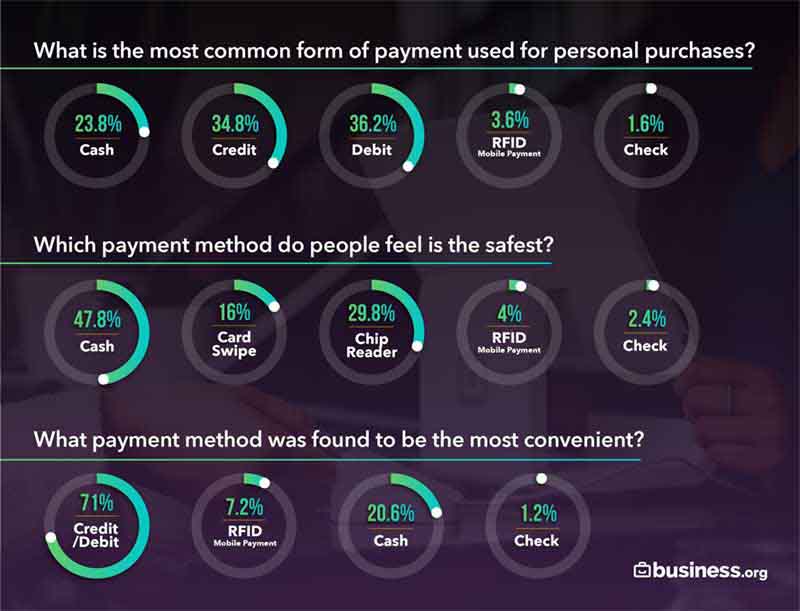
It turns out that convenience is king, which ultimately means that cards are king. Most people pay with cards these days, followed by cash. Very few people (only 5.2%) pay with either checks or RFID mobile payments (sometimes called contactless payments).
Furthermore, even though over 71% of Americans use cards the most, only 42.8% feel using a card is the safest payment method.
Only 16% of respondents said swiping a card is safest. But Americans have more confidence in chip readers: 29.8% said a card with an RFID chip is the safest way to pay.
When it comes to safety, cash still feels like the safest way to pay. Almost half of our respondents said cash is the safest, but only 23.8% said they use it the most.
So if you’re a business, you need to make it as easy as possible for people to pay for your products and services. That means you need to accept both debit and credit cards. A cash-only plan isn’t viable anymore.
Methodology
Our rankings were created by comparing over 20 of the top POS systems on the market today. We looked at pricing, features, customer satisfaction, and usability. We also took into account the most common and important business use cases like, for example, a POS for managing a restaurant. Once we accounted for all these considerations, we determined the top five choices.
Disclaimer
At Business.org, our research is meant to offer general product and service recommendations. We don't guarantee that our suggestions will work best for each individual or business, so consider your unique needs when choosing products and services.
Sources
- Shopify, “About.” Accessed May 3, 2023.
- Heartland, “Read the Announcement.” Accessed May 3, 2023.
